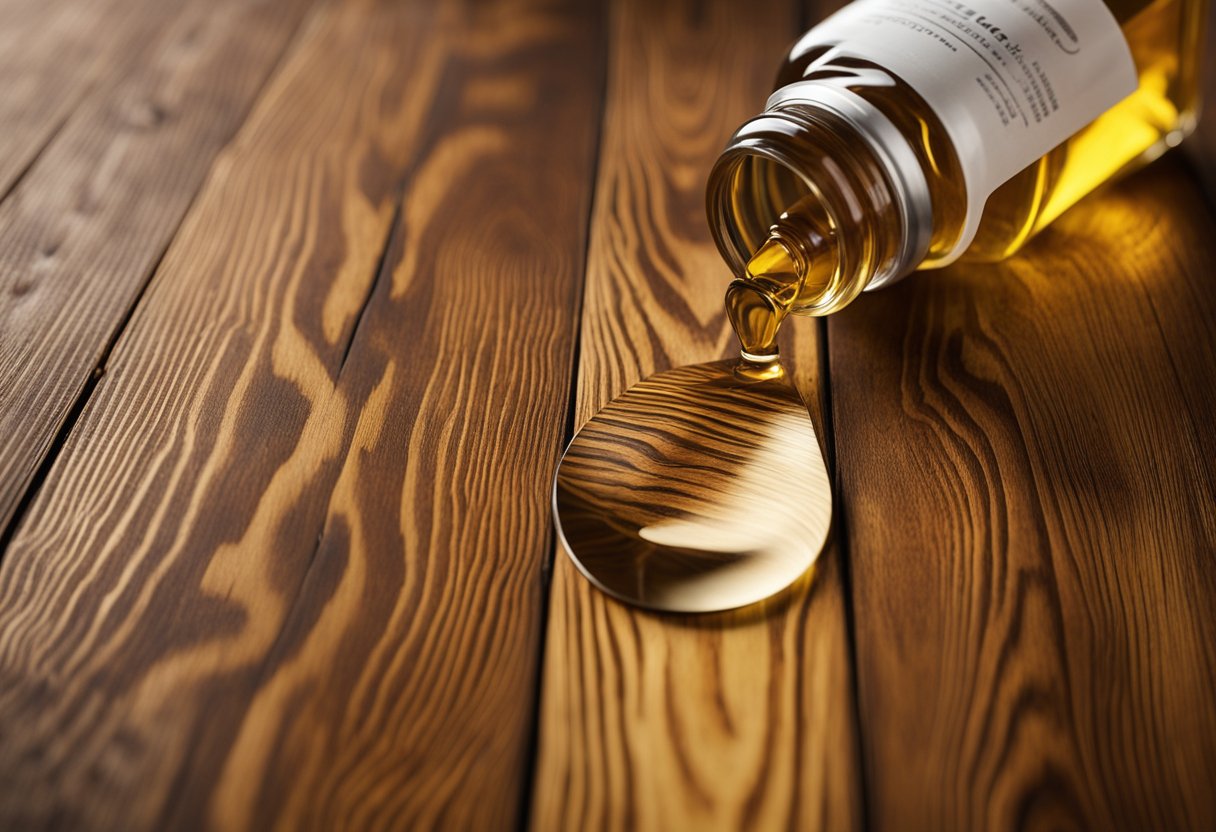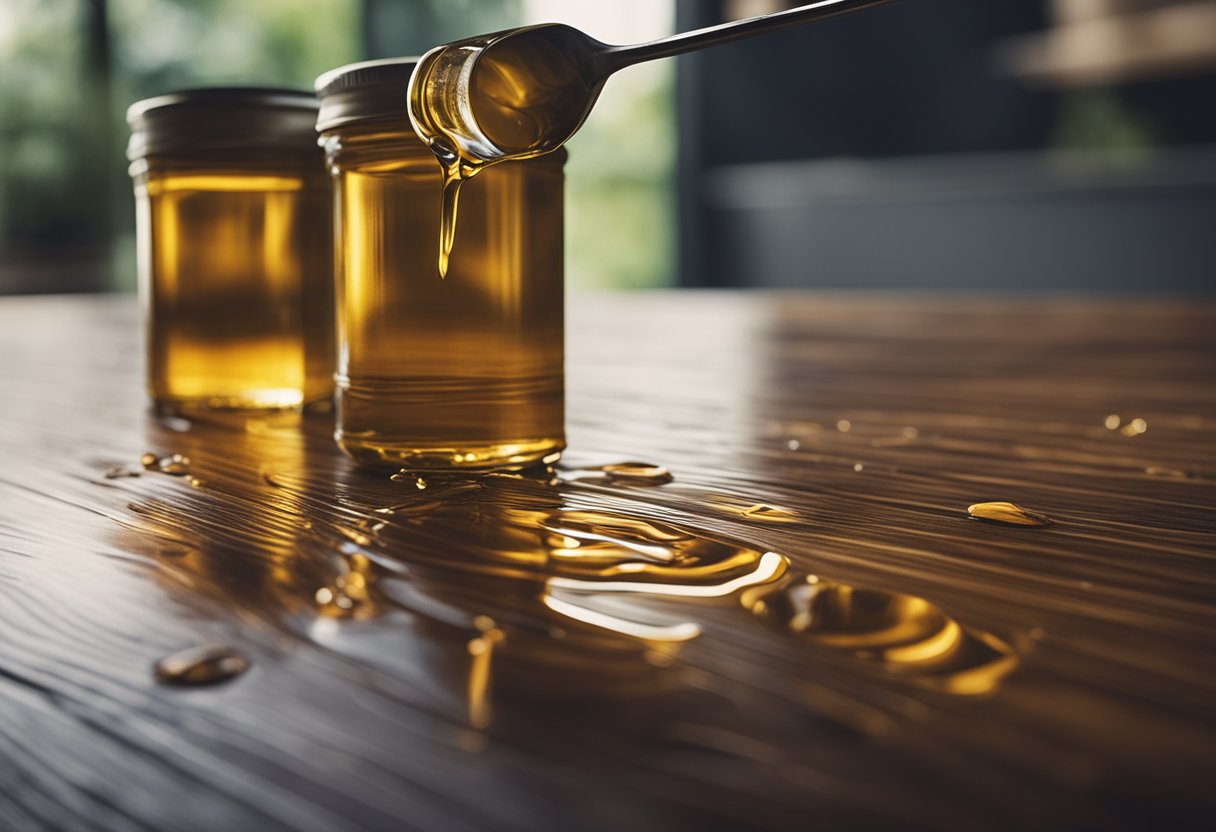I have researched the topic of applying linseed oil over stain and found some interesting information. Linseed oil is a popular wood finish that can be used on top of stains to create a shiny appearance. However, there are some important considerations to keep in mind when using linseed oil over stain.
It is important to understand the properties of linseed oil and how it compares to other wood finishes. Linseed oil is a natural oil that penetrates the wood and hardens when exposed to air. It is a thick coating that can create a glossy finish on the wood surface. Compared to other finishes, linseed oil is less durable and requires more maintenance. However, it is also more environmentally friendly and can enhance the natural beauty of the wood.
Key Takeaways
- Linseed oil can be used over stains to create a shiny appearance on the wood surface.
- Linseed oil is a natural oil that penetrates the wood and hardens when exposed to air.
- Linseed oil is less durable than other finishes but can enhance the natural beauty of the wood.
Understanding Linseed Oil
https://www.youtube.com/watch?v=9yq6VW-c2Ts&embed=true
As a woodworking enthusiast, I have come across many types of finishes, and one of the most popular is linseed oil. Linseed oil is a natural product derived from the seeds of the flax plant. There are two types of linseed oil, raw and boiled. Raw linseed oil is the purest form and takes longer to dry. Boiled linseed oil, on the other hand, has additives that make it dry faster.
Linseed oil is eco-friendly and non-toxic, making it an excellent choice for those who want to avoid harsh chemicals. It is also a popular choice among woodworkers because of its ability to enhance the natural beauty of wood. Linseed oil penetrates deeply into the wood, bringing out the grain and color.
One of the benefits of linseed oil is that it is easy to apply. You can apply it using a brush, cloth, or even your hands. Linseed oil is also versatile, and you can use it on any type of wood, including hardwoods and softwoods.
When using linseed oil, it is essential to note that it takes time to dry. You should apply the oil in thin coats and allow each coat to dry completely before applying the next. This will ensure that the oil penetrates deeply into the wood and enhances its natural beauty.
In conclusion, linseed oil is a natural and eco-friendly finish that is easy to apply and enhances the natural beauty of wood. Whether you choose raw or boiled linseed oil, you can be confident that you are using a non-toxic product that is safe for you and the environment.
Linseed Oil vs Other Wood Finishes
https://www.youtube.com/watch?v=aklfthQN-q8&embed=true
As a woodworker, I have experimented with various wood finishes, including oil finishes, polyurethane, and teak oil. However, linseed oil remains one of my go-to finishes for many projects.
Linseed oil is a natural finish that enhances the natural beauty of wood. It penetrates deep into the wood fibers and hardens to form a protective layer that is resistant to water and scratches. Unlike polyurethane, which forms a thick layer on top of the wood, linseed oil leaves the wood with a natural, matte finish.
Tung oil is another popular wood finish that is often used in conjunction with linseed oil. Tung oil is a harder finish than linseed oil and is often used on its own. However, tung oil can take longer to dry and may require multiple coats to achieve the desired level of protection.
Danish oil is a blend of linseed oil, varnish, and mineral spirits. It is a popular finish for furniture and other indoor projects. Danish oil dries faster than linseed oil and provides a more durable finish.
Polyurethane is a synthetic finish that is often used on floors and other high-traffic areas. It forms a thick layer on top of the wood that is resistant to scratches and water. However, polyurethane can be difficult to apply and can leave brush marks if not applied correctly.
Wood oil is a general term that refers to any oil-based finish that is used to protect and enhance the natural beauty of wood. It can include linseed oil, tung oil, and other oils. Wood oil formulations can also include pigments to double as wood stains.
Overall, there are many alternatives to linseed oil for finishing wood projects. Each finish has its own unique properties and advantages. However, linseed oil remains a popular choice for those who want a natural, matte finish that enhances the natural beauty of wood.
Application of Linseed Oil Over Stain
https://www.youtube.com/watch?v=cFN7H6vPDCE&embed=true
As a woodworking enthusiast, I have often wondered whether it is possible to apply linseed oil over stain. After conducting some research and experimenting with different techniques, I have discovered that it is indeed possible to use linseed oil over stain to achieve a beautiful and durable finish on wooden surfaces.
The first step in applying linseed oil over stain is to ensure that the surface is clean and free of dust and debris. I recommend using a clean brush or rag to apply the linseed oil to the surface of the wood. It is important to work quickly and evenly, applying the oil in thin, even coats to avoid pooling or drips.
Once the linseed oil has been applied, it is important to wipe off any excess with a clean rag or brush. This will help to ensure that the oil is absorbed evenly into the wood and that the finish is smooth and consistent.
After the initial application, it is important to allow the linseed oil to dry completely before reapplying. This drying process can take anywhere from a few hours to a few days, depending on the temperature and humidity in your workspace.
Overall, applying linseed oil over stain is a great way to achieve a beautiful and durable finish on wooden surfaces. With a little bit of patience and attention to detail, anyone can achieve professional-quality results with this versatile and easy-to-use finish.
Preparation and Precautions
Before applying linseed oil over stain, proper preparation is necessary to ensure the best results. Here are some steps that I follow:
-
Clean the surface: It is essential to clean the surface of the wood thoroughly before applying linseed oil. Any dust, dirt, or debris on the surface can affect the finish. I use a lint-free cloth to wipe down the surface and remove any dirt or dust particles.
-
Sand the surface: Sanding the surface of the wood with sandpaper helps to smooth out any rough spots and allows the linseed oil to penetrate the wood grain better. I use a fine-grit sandpaper to avoid any scratches on the surface.
-
Apply the stain: If the wood has not been stained yet, apply the stain first and wait for it to dry completely before applying the linseed oil. This helps to enhance the color and grain of the wood.
-
Apply the linseed oil: Once the surface is clean and dry, apply the linseed oil using a clean lint-free cloth. I apply a thin layer of linseed oil and let it dry for at least 24 hours before applying another coat.
It is essential to take precautions when working with linseed oil as it is flammable and can cause skin irritation. Here are some safety tips that I follow:
-
Work in a well-ventilated area: Linseed oil fumes can be harmful, so I always work in a well-ventilated area to avoid inhaling them.
-
Wear protective gear: I wear gloves and protective eyewear to avoid skin irritation and eye damage.
-
Dispose of rags properly: Linseed oil-soaked rags can be a fire hazard, so I dispose of them properly by placing them in a metal container with a tight-fitting lid.
By following these preparation and precautionary steps, I have achieved a smooth and shiny finish on my wooden surfaces with linseed oil over stain.
Benefits of Linseed Oil Over Stain
As a woodworker, I have found that using linseed oil over stain has several benefits. Here are some of them:
1. Protective
Linseed oil is a natural finish that provides a protective layer to the wood surface. It penetrates deep into the wood fibers, which helps to prevent water damage and other environmental factors that can cause damage to the wood. Additionally, it acts as a barrier against scratches and stains, which can help to keep your wood furniture looking new for a longer period of time.
2. Natural beauty
One of the best things about using linseed oil over stain is that it enhances the natural beauty of the wood. It brings out the wood’s natural grain patterns and colors, which can make it look more stunning. The oil also gives the wood a warm and rich glow that is hard to achieve with other finishes.
3. Water-resistant
Linseed oil is naturally water-resistant, which means that it can help to protect your wood furniture from water damage. This is especially important if you plan to use your furniture outdoors or in areas where it may be exposed to water or moisture.
4. Long-lasting
Linseed oil is a long-lasting finish that can provide protection to your wood furniture for years to come. It doesn’t crack or peel like some other finishes, which means that you won’t have to reapply it as often. Additionally, it can help to prevent the wood from drying out, which can lead to cracking and splitting.
5. UV light protection
Linseed oil is also great for protecting your wood furniture from UV light damage. It helps to prevent the wood from fading or turning gray over time, which can be a problem with other finishes.
6. Environmentally friendly
Linseed oil is a natural product that is environmentally friendly. It is made from flax seeds, which are a renewable resource. Additionally, it doesn’t contain any harmful chemicals that can be harmful to the environment.
Drawbacks and Solutions
https://www.youtube.com/watch?v=bsjnRcmC840&embed=true
While linseed oil has many benefits when used over stain, there are also some drawbacks to consider. In this section, I will discuss the cons of using linseed oil over stain and provide some solutions to these drawbacks.
Cons
Time-Consuming
One of the biggest drawbacks of using linseed oil over stain is that it can be time-consuming. Linseed oil takes a long time to dry, and you will need to wait at least 24 hours before applying a second coat. If you are in a hurry to finish your project, linseed oil may not be the best choice.
Yellowing
Another potential issue with linseed oil is that it can yellow over time. This is especially true if you use raw linseed oil instead of boiled linseed oil. To avoid this issue, you can use boiled linseed oil, which has been treated with solvents and metals to prevent yellowing.
Solutions
Buffing
One way to speed up the drying process is to buff the surface of the wood after applying the linseed oil. This will help to remove any excess oil and speed up the drying process. You can use a soft cloth or a buffing wheel to do this.
Solvent
To avoid yellowing, you can use boiled linseed oil instead of raw linseed oil. Boiled linseed oil has been treated with solvents and metals to prevent yellowing. It is also a good idea to apply a thin coat of shellac over the linseed oil to protect it from UV light.
Pros
Despite these drawbacks, linseed oil has many benefits when used over stain. It enhances the natural color of the wood, brings out the depth of the wood color, and adds a unique appearance to your furniture and woodwork. Additionally, linseed oil is eco-friendly, elastic, and water-resistant.
Maintenance and Care
https://www.youtube.com/watch?v=eDGAN15GER8&embed=true
As someone who has worked with linseed oil over stain in various woodworking projects, I can attest to the fact that it is a durable and beautiful finish. However, like any other finish, it requires proper maintenance and care to ensure its longevity.
One of the primary benefits of using linseed oil over stain is that it provides a protective layer against moisture and humidity. However, it is still important to keep your furniture or woodworking project away from damp areas and to wipe up any spills or moisture as soon as possible.
Regular cleaning is also essential to maintain the finish’s appearance. A simple dusting with a soft cloth or a gentle wipe down with a damp cloth can help remove any dirt or debris that may accumulate over time.
If you notice any mildew growth on your oiled wood surface, it is essential to address it immediately. Mildew can cause permanent damage to the wood and the finish. A mixture of equal parts water and white vinegar can be used to clean mildew from the surface. Be sure to rinse the surface thoroughly with water and dry it completely.
In addition to regular cleaning, periodic reapplication of linseed oil can help maintain the finish’s appearance and durability. Depending on the level of use, it is recommended to reapply linseed oil every six months to a year.
Overall, proper maintenance and care are crucial to ensure the longevity of your linseed oil over stain finish. With the right care, your furniture or woodworking project can retain its beauty and durability for years to come.
Conclusion
In conclusion, applying linseed oil over stain is possible and can lead to a beautiful finish on wood. However, it is important to note that the final result will depend on various factors such as the quality of the wood, the type of stain used, and the application technique.
When applying linseed oil over stain, it is important to ensure that the wood is clean and free of dust or debris. This can be achieved by wiping the wood with a clean cloth or using a vacuum cleaner.
It is also important to note that linseed oil is a finishing oil that penetrates the wood fibers and pores, providing a protective layer against moisture and other damaging elements. As such, it is a popular choice among woodworkers for wood finishing.
To achieve the best result when applying linseed oil over stain, it is recommended to use a high-quality finishing oil and to apply it in thin, even coats. This will allow the oil to penetrate the wood fibers and pores, resulting in a smooth and even finish.
Overall, applying linseed oil over stain can be a great way to enhance the beauty and durability of wood. However, it is important to take the necessary precautions and to follow the proper techniques to achieve the best result.
Frequently Asked Questions
Can linseed oil be used over wood stain?
Yes, linseed oil can be used over wood stain. According to Carpentering Lab, linseed oil can penetrate through wood fibers to make them saturated and create a protective and attractive coating. However, it is better not to apply linseed oil over stain because linseed oil works well on bare or oiled wood, as stated by WoodWorkly.
Is it better to apply linseed oil before or after staining wood?
It is better to apply linseed oil after staining wood, as stated by PaintsGeek. This is because linseed oil will not adhere to dirty or dusty surfaces, so it is important to make sure that the wood is completely clean before applying boiled linseed oil.
Can boiled linseed oil be applied over Minwax stain?
Yes, boiled linseed oil can be applied over Minwax stain, according to Reddit. Stain is just color, so adding linseed oil will provide slight protection and seal it against moisture and humidity.
Can tung oil be used over wood stain?
Yes, tung oil can be used over wood stain, as stated by Bob Vila. Tung oil is a natural oil that penetrates deeply into wood, providing a protective layer that is resistant to water, stains, and scratches.
Will linseed oil darken the color of wood stain?
Yes, linseed oil can darken the color of wood stain, as stated by Carpentering Lab. However, the degree of darkening will depend on the type of wood and stain used.
Does linseed oil provide a protective seal over wood stain?
Yes, linseed oil can provide a protective seal over wood stain, as stated by Reddit. Adding linseed oil will provide slight protection and seal it against moisture and humidity.

Hi, I’m Sal Muller of Tooltrip.com. My DIY experience led me to understand essential power tools for home projects. Tooltrip.com guides enthusiasts and professionals in choosing right tools for any job. I provide concise top tool reviews for easier, efficient DIY.






